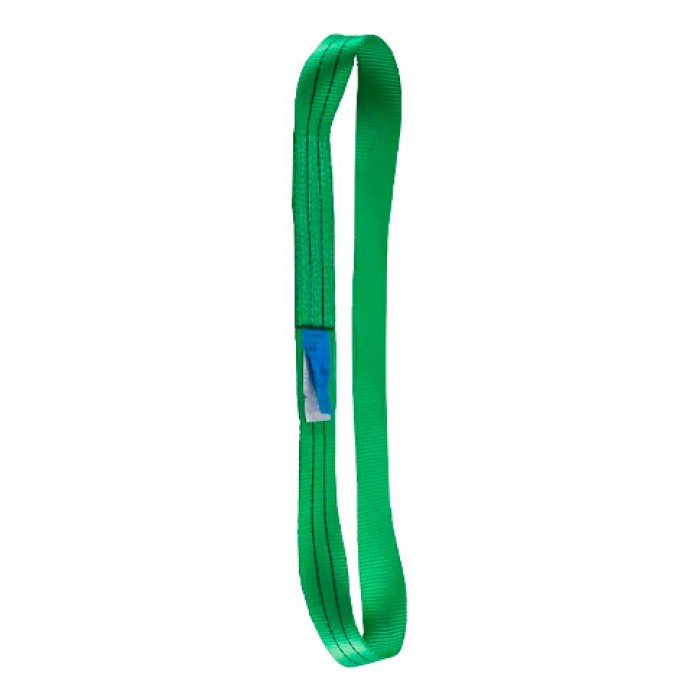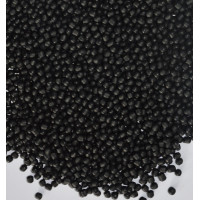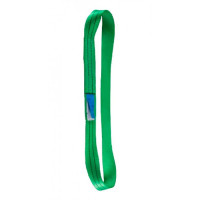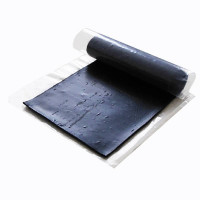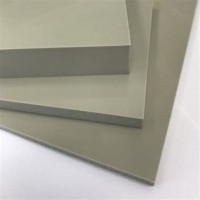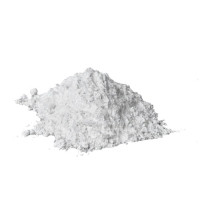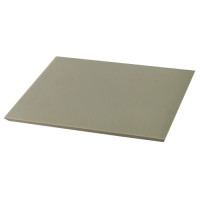Textile loop sling STP 4.0 t are an excellent choice when solving problems of lifting and moving delicate loads. Thanks to the soft and wide polyester synthetic tape, the likelihood of damage to the surface of the load is minimal. In addition, working with fabric tape slings is easy, pleasant and safe. Also, thanks to the properties of textile slings such as lightness, compactness and corrosion resistance, they are ideal for equipping tow trucks, truck cranes and loader cranes.
Advantages of STK slings:
low dead weight;
safety (they do not injure the slinger due to the low weight and the absence of sharp burrs and protruding wires as in rope slings);
compactness, flexibility, elasticity (easily folded, occupying a minimum volume, and, importantly, also easily return to its original form after unpacking);
do not damage fragile and delicate cargo;
Thanks to the ability of the tape to elongate by 3%, small dynamic vibrations are smoothed out.
Flaws:
are easily damaged by sharp edges of the load;
are operational only strictly in temperature conditions from -40 to +100 °C.
Textile slings come in two main types: flat (ribbon) and round (round-strand). They can be made from a variety of materials, but they are most often made of nylon or polyester. The two materials are very similar in appearance and it is difficult for anyone but the most experienced person to tell them apart visually. This is one reason why you should always check the markings on the sling before use.
Synthetic fiber rigging slings have the following general properties:
Strength - depending on the size, slings made of synthetic fabric can withstand loads of up to 100 tons.
Convenient and safe - the flexible strap adapts to the contour of the load and holds it with a tight, non-slip grip.
Protects Loads from Damage - Unlike other sling materials, the webbing's soft texture is less likely to damage, mar, or scratch polished surfaces.
Shock Absorbing Capacity – Minimizes shock loads and shocks.
Heat resistance - the load-bearing capacity of the synthetic material is not affected by temperatures up to 82 degrees Celsius.
Cost-effective – slings made of synthetic fabric have a low initial cost and a long service life. They are unaffected by mold, rot or bacteria, are resistant to some chemical attacks and have excellent abrasion resistance.
Synthetic slings are extremely versatile and can be used in vertical, ring and basket hitches. They are easy to transport and set up with just one person, making them an excellent choice for general lifting applications.
Features of polyester slings
Approximately 3% elongation at rated load capacity - low shock absorption allows for better load control during lifting.
Polyester is a softer material and less abrasive to sensitive or delicate surfaces.
Lower moisture absorption compared to nylon, quick drying.
Polyester slings can be used in explosive environments (for example, in the mining industry), the material is non-sparking and non-conductive.
Resistant to acidic environments and interaction with bleaches, oils and fats.
Polyester is available at a relatively lower cost than nylon.
Not recommended for alkaline media, including aldehydes, ethers and strong alkalis.
Cannot be used at temperatures above +90°C or below -40°C.
Features of nylon slings
8-10% elongation at rated load capacity - this reduces impact loads, but high elongation must be taken into account for low ceiling height lifts.
Resistant to grease and oil.
Resistant to aldehydes, ethers and strong alkalis.
Nylon slings are not recommended for acidic environments or for use with bleach.
High moisture absorption, which can increase elongation under load.
Conducts electricity due to its ability to retain moisture.
Cannot be used at temperatures above +90°C or below -40°C.
Conclusions:
Polyamide (nylon) slings are more elastic, they better resist the transfer of shock loads to the crane. However, they lose more than 15% of their load-carrying capacity when wet and should not be used near acids or bleaches.
Polyester slings are softer and adhere better to the surface of the load. They have low elongation and therefore transfer slightly more instantaneous load to the crane when an impact load occurs. They cannot be used near ethers and alkalis, but are resistant to acids.
Both nylon and polyester slings are suitable for easily damaged loads, but if you are wondering which one is better to use for the most delicate loads, it is polyester. Chemical coating of nylon tape gives it a rougher texture.
If withthe trail is used in a chemically active environment, be sure to choose a material that will not be damaged. Chemicals may be found in the air or on any surface that the device may come into contact with. It would be unwise to lift lead-acid battery trays with nylon slings or lift alkali tanks for industrial cleaning with polyester slings. Any synthetic material can be damaged by certain chemicals. Before using slings in chemically active environments, their resistance to aggressive substances should always be taken into account. When working with hot materials or in very hot or cold conditions, nylon or polyester slings may not be the best choice.
Textile sling options
Requirements for the design, materials and safety of general-purpose cargo slings made of textile tape are defined in the RD and TU documents, which were developed by specialists from manufacturing companies.
Explanation of some designations of textile slings:
STK – ring
STP - single loop with soft loops
1ST, 2ST, 3ST, 4ST - one-, two-, three- and four-leg with hooks and a ring
The letter "K" is added to round-spun products:
STKK - ring round strand
STPK - single loop round
The most popular and universal are ring (STK) and loop (STP) slings. The ring configuration is designed for tying loads (not hooking) and allows the user to rotate the hook and load contact points, which increases the durability of the straps.
Loops are often called "rag chucks" and have the ends (loops) wrapped with extra material to prevent rapid wear and tear at the contact points.
Load-handling devices 1ST, 2ST, 3ST, 4ST allow you to organize the lifting of cargo using one, two, three or four lifting gripping points. Their branches are united by an upper power ring for hanging on a crane hook and can have various designs of metal end elements (hooks, rings, brackets).
What is the minimum and maximum width of the slings?
Flat tape slings come in different widths ranging from 30mm to 300mm. Models with a lifting capacity of up to 1 ton usually have a width of 30-50 mm, two-ton - 60-65 mm, three-ton - 85-100 mm, etc. Most types of slings have from 1 to 4 layers sewn together. The production of multilayer models made it possible to increase the load capacity without increasing the width of the belt. Their maximum flexibility and strength is determined by the number of layers sewn together.
What is a round sling?
A round (round-strand) sling is a looped sling (STPK) or a closed ring (STCK) consisting of an internal load-bearing polyester core covered with a wear-resistant woven seamless sheath made of polyester or nylon yarn. Since the base consists of a bunch of polyester threads, its body is soft, elastic and very durable.
Circular strand sling - photo
Circular sling
What are the advantages of round slings?
Round slings are superior to tape slings in ductility and load-carrying capacity; they are able to twist and bend in any direction, are easily wound under a load and are better able to withstand long-term dynamic loads.
The fabric outer sleeve protects the internal load-bearing fibers from mechanical damage, abrasion, dirt, oiling, as well as from ultraviolet radiation, so the service life of round-strand fibers is an order of magnitude higher than that of flat tape counterparts.
Round strand ring slings allow you to organize almost any slinging method, they are especially useful when lifting pipes, poles, logs, cylindrical objects and loads with uneven contours.
The closed ring shape allows you to change the points of contact with the load and extend the life of the device, and since the core threads do not come into direct contact with the load, there is no loss of strength due to abrasion.
Less stretch (about 3%) at rated load capacity prevents "bounce" when lifting. After the load is removed, the product returns to its original length.
The sheathed round sling is an economical choice for heavy-duty lifting or hauling systems. Although it is preferable to use for heavier loads (from 6 tons), the choice depends on your personal preferences.
What is the safety margin of textile slings?
The term load rating refers to the maximum working load that the sling manufacturer claims it can withstand. Tape and round strand load handlers made from high-strength synthetic fibers are manufactured with safety factors of 6:1, 7:1 and even 8:1, meaning they have a tensile strength of six/seven/eight times the rated working load limit. But this does not mean that they can be loaded in excess of the rated load capacity. Impact and lateral loads negatively affect their strength.
How does the sling angle affect the lifting capacity?
STP sling - photo
When pageThe supports are used at an angle during lifting; their load capacity is reduced, as additional tension is created on the branches. As the angle between the slings increases, the breaking force on each leg increases. Acceptable angles are up to 90° and no more than 120°.
For example, if the angle α is 90°, then each leg of the sling experiences a load equal to 71% of the weight of the load. And with α equal to 120°, each leg already experiences a force equal to the weight of the load. In any case, the slinger must take into account the angular stress of the branches and use reduction factors for the lifting capacity.
When lifting directly (vertical position of the coupling device), the coefficient is 1, which means you can use the full lifting capacity of the sling.
When slinging “with a noose”, the coefficient is 0.8, that is, the load capacity of the chuck is reduced by 20%.
With the “basket” slinging method, if the branches are located vertically at an angle of 90° to the horizontal, a factor of 2 is applied, and the lifting capacity of the sling is doubled.
What is the shelf life of synthetic slings?
Weather conditions, environment, intensity of use - all play an active role in determining the service life of slings. During use, never exceed the rated working load limit and avoid shock loads. On average, the shelf life of a textile tape sling is 3 months, subject to intensive use in one work shift.
You should always minimize sling movement on any surface during lifting, dragging on the ground, and never pull the sling out from under the load. Avoid heat exposure and weld spatter, as well as the use of hooks, shackles and other hardware with burrs or rough edges. Do not allow vehicles to hit the seat belts.
We would be remiss if we did not take into account the possible abrasion of synthetic slings. They can become abrasively damaged or even melt at room temperature due to the friction caused by moving across a surface under load. Always consider the effects of abrasion and the different ways to protect the sling during use. For example, you may want to wear corner protectors or sleeves where wear is expected, especially where the load has sharp edges.
Storage conditions also affect the overall integrity and strength of the tooling, which encourages consumers to ensure optimal storage conditions - a cool, dry place, protected from UV exposure, away from chemicals and heat sources.
Advantages and disadvantages
The advantages of using textile slings are:
strength;
wear resistance;
flexibility;
maneuverability;
non-abrasive surface structure;
light weight (compared to steel and chain slings);
the possibility of pairing them with a wide variety of lifting equipment.
Due to these characteristics, working with the vehicle is quite easy and convenient. Textile slings are ideal for lifting and moving loads that require special care (wood, insulated pipes, all kinds of finishing structures, for example).
Textile slings do not rust, are not subject to deformation or creases, and have excellent resistance to chemicals (when selecting a sling, you must pay attention to the specific base material).
The safety of using this type of rigging devices in work lies in the absence of steel hairs on them (for example, like a rope), which can cause injury to workers. Textile slings are easy to clean from dirt, convenient to fold, transport and store.
Among the disadvantages of slings are:
the difficulty of transporting them along with sharp and cutting objects;
tendency to elongate (within 6%) during long-term use.
In addition, experts note the inconvenience of use when loading large cargo - an increase in load capacity requires a noticeable increase in the width of the slings.
From us you can buy Textile loop sling STP 4.0 t at the best price in Ukraine. A wide range of products allows us to quickly and efficiently fulfill any orders, helping to complete any construction work on time.
No questions about this product, be the first and ask your question.

